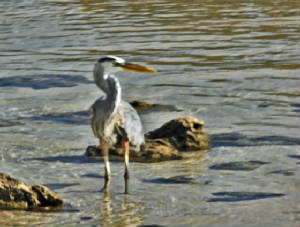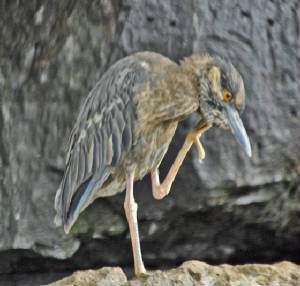|
Home
Coastal Birds
Coastal birds differ from sea birds in their feeding area, Sea birds roam out to sea to feed while Coastal birds feed along the coastline and in inland bodies of water.
The
Great Blue Heron is the largest heron on the Galapagos. It stands 3 feet high and has a wing span of 6 feet.
Their diet consists of small fish, crabs,lizards,young iguanas and young birds. The Great Blue Heron is native to the
Galapagos but is not a species unique to them.
This one is obviously on a fishing trip.
This one is obviously on a fishing trip.
and this one is enjoying a Sally Lightfoot Crab smorgasbord.
The Salad bar is on next rock.
Headed for the dessert table?

The Great White Egret is slightly smaller that the Great Blue Heron.
Its' feeding habits are similar to the heron but it also
supplements its diet with locusts, grasshoppers and other insects.
Its' feeding habits are similar to the heron but it also
supplements its diet with locusts, grasshoppers and other insects.
The
Lava Heron is only found in the Galapagos.
It stands 16-17 inches high so it is much smaller than
the previous herons shown. Its diet consists of fish, crabs, lizards and insects.
It stands 16-17 inches high so it is much smaller than
the previous herons shown. Its diet consists of fish, crabs, lizards and insects.
This
Lava Heron is fishing in a mangrove thicket.
They may even dive into the water to capture a particularly
tasty
morsel of food.
The Striated Heron, while not endemic to the Galapagos is
a
native, spending all is time in these beautiful islands.

This
Yellow-crowned Night Heron is an endemic sub-species found only in the Galapagos.
It feeds on crabs, locusts, scorpions
(maybe I can import a few to Texas) and other insects.
Other
groups in our expedition were lucky enough to find the group of Greater Flamingos in a lagoon.
Unfortunately, there were moving to better feeding grounds when I saw them.
Unfortunately, there were moving to better feeding grounds when I saw them.
|
|